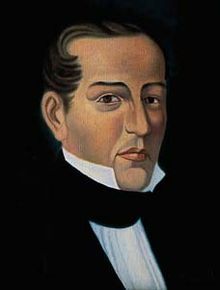José María Heredia
José María Heredia y Heredia (born December 31, 1803 in Santiago de Cuba , † May 7, 1839 in Mexico City ) was a Cuban poet . Together with Gertrudis Gómez de Avellaneda , he was one of the most important representatives of the Cuban Romanticism of the 19th century.
Live and act
Born in Santiago de Cuba as the first child of Spanish parents who came from what is now the Dominican Republic , José María Heredia spent a large part of his childhood in numerous places in the Caribbean region, for example in the then Spanish colony of Florida , in Santo Domingo and in Venezuela , where his father was a senior official in the Spanish government and a judge. In 1816 he took a Latin exam at the University of Caracas . From 1818 he studied law in Havana , from 1819 in Mexico City . After his father was murdered in October 1820, he returned to Cuba, was supported by his uncle and worked for a short time as a lawyer. Due to his activities to achieve independence , as a participant in a conspiracy and because he had to fear persecution as a Freemason , he spent a large part of his life in exile in the USA since 1823 and in independent Mexico since 1825 . There he served as an officer, was a member of parliament and since 1833 professor of literature and history, secretary to General Santa Anna and minister. He worked as a translator and with numerous Mexican literary magazines and revised the draft for the new Mexican criminal law.
Heredia was sentenced to death in absentia by a Spanish court in 1831. After he publicly renounced his ideas of independence - not least because of the experience of post-revolutionary chaos in Mexico - he was allowed to return to Cuba in 1836. There he met again with like-minded people, including his former mentor Domingo del Monte , but his friends criticized his distancing from the independence movement. He was expelled from the country after just four months and returned to Mexico in February 1837, seriously ill. There he died of tuberculosis in 1839 . His remains were thrown into a communal grave in 1847; there is no grave with his name.
His widow Jacoba Yáñez Echeverría died four days after her return from exile in 1844 at the age of 33 in Matanzas . The couple left behind two children, José de Jesús Heredia (1836-1926) and Loreto Heredia de Lamadrid (1829-1910). Two other daughters and a son died as young children. His mother died in Cuba in 1857. Heredia's birthplace has been set up as a museum and gallery. The Oda a Niágara is let into the wall of the house . There is also a bronze plaque with verses from this ode to Niagara Falls.
Works
Heredia is considered the first great romantic poet of the American continent and one of the most important Spanish-speaking poets of the era. He is often viewed as a Cuban national poet; its importance is compared to that of Walt Whitman for North America. His patriotic verses like La estrella de Cuba ("The Star of Cuba") are often quoted.
Heredias' oldest surviving and datable poems date from 1817. His most important works include his odes, which are as musical as they are melancholy. The best known are En el Teocali de Cholua (1820), which was created after visiting the Mexican temple ruins of the Aztecs , and Oda a Niágara (1824), in which he describes his impressions of Niagara Falls . Heredia also wrote sonnets and dramas, some based on European works. During his stay in New York he translated the Ossian into Spanish and thus contributed to the enthusiasm for the Middle Ages in Latin America. He has also translated works by Thomas Moore , Lord Byron , Walter Scott , Daniel Webster , Voltaire and Goethe .
The authorship of the historical novel Jicoténcal , which was published anonymously in 1826, is very doubtful; Its author was probably the Catholic priest Félix Varela (1788-1853).
In his novel La novela de mi vida, Leonardo Padura treats Heredia's life in a fact-based, but largely fictional form.
- Factory editions (digital copies)
Web links
- Biography of José María Heredia at Escritores.org (Spanish)
- José María Heredia at the Cuban online encyclopedia EcuRed (Spanish)
Individual evidence
- ↑ a b Ted Henken: Cuba: A Global Studies Handbook , ABC-CLIO (2007), ISBN 978-1-85109-984-9 . P. 364 f.
- ↑ CV in: www.cubaliteraria.com.
- ↑ Barcelona 2002; German edition: Die Palme und der Stern , Zurich 2015.
| personal data | |
|---|---|
| SURNAME | Heredia, José María |
| ALTERNATIVE NAMES | Heredia y Heredia, José María (full name) |
| BRIEF DESCRIPTION | Cuban poet |
| DATE OF BIRTH | December 31, 1803 |
| PLACE OF BIRTH | Santiago de Cuba |
| DATE OF DEATH | May 7, 1839 |
| Place of death | Mexico City , Mexico |

